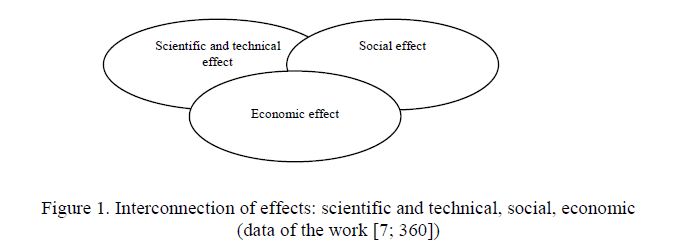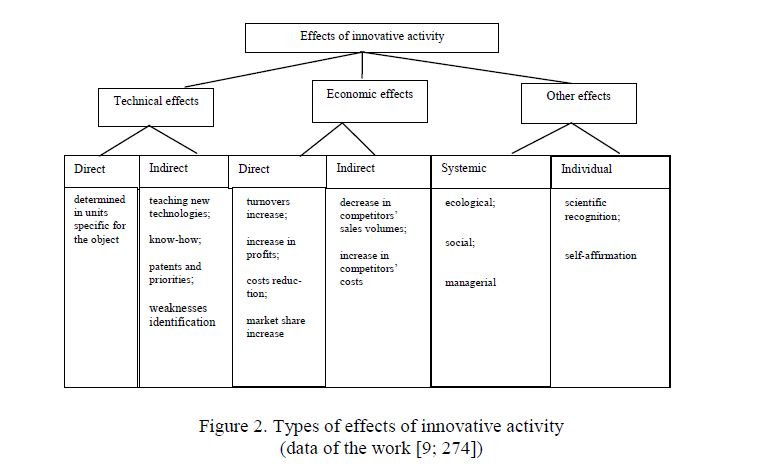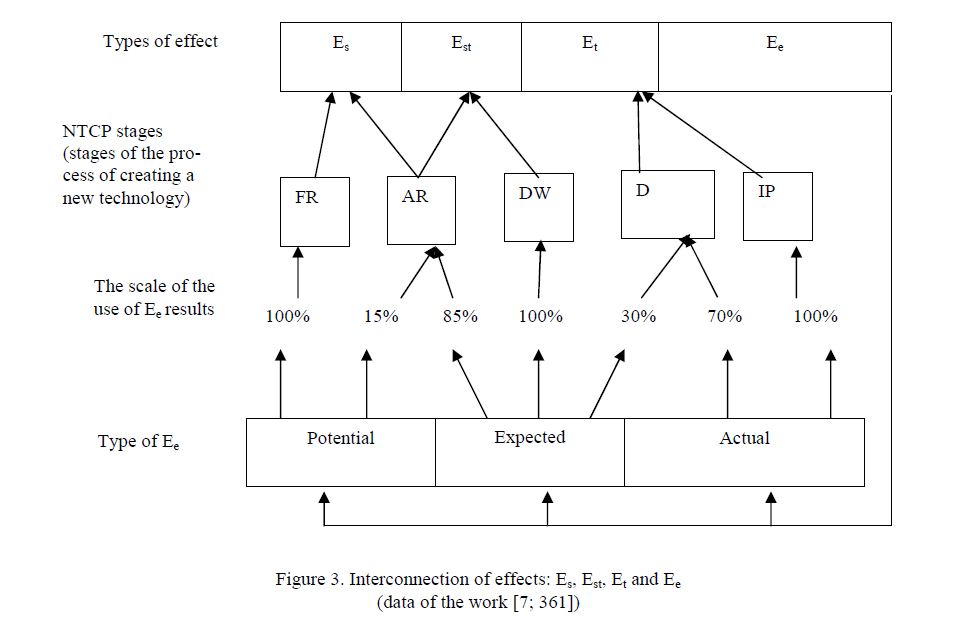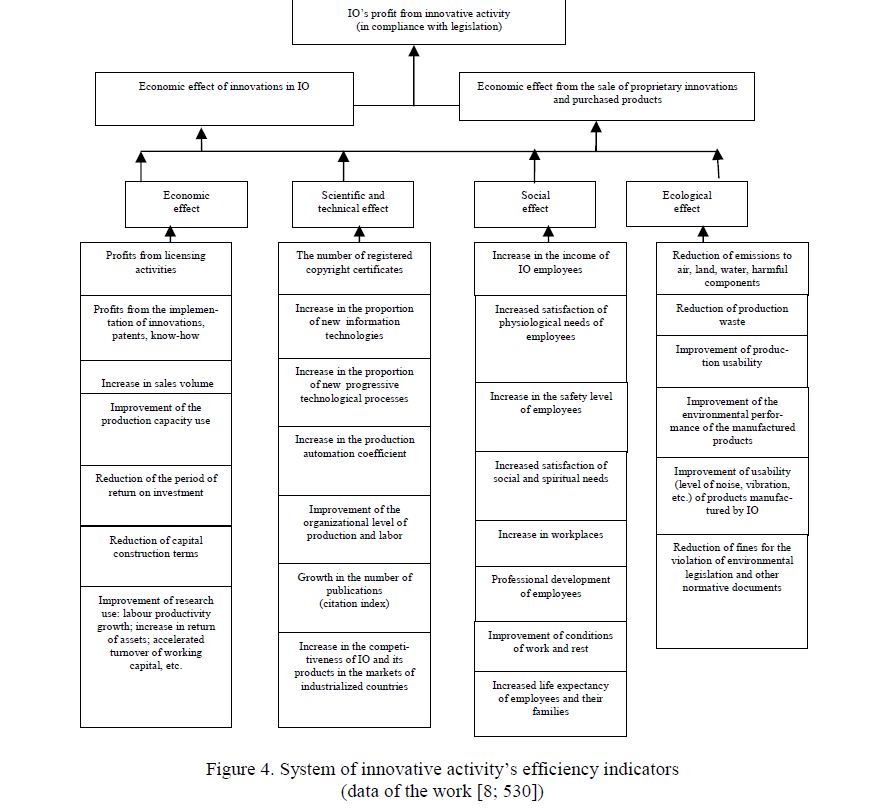It is noted that today there are no uniform views concerning the criteria and methods for assessing the effects of innovations. The attention is paid to the classification of effects of the innovative activity. The effectiveness of costs for the innovative activity is considered. The possibility of cost accounting and effect types of work in the field of science is revealed. The necessity of the use of the system of estimated indicators of innovations’ efficiency is justified. Methodical bases of the organization of the analysis of the innovative activity’s efficiency are stated.
Assumptions and limitations that are the basis for the approaches set up in the existing methods to assess the effects of innovations and the efficiency of innovative processes
Today there are no uniform views on the criteria and methods for assessing the effects of innovations [1–3].
In recent years, approaches, according to which the methodology and techniques of investment calculations are used to assess the economic effect of innovations, have become fairly widespread. These approaches are quite justified, when we are talking about assessing the effectiveness of investments in innovation at the stage of pilot batch manufacturing and organization of mass production. In such a case, we should talk about the investment project, the efficiency of which can be assessed through a variety of methods of investment calculations [4–6].
Approaches for assessing the effects of innovations and the efficiency of innovative processes set out in the existing methods are based on the following assumptions and limitations:
- the effect of innovations is measured and assessed at the level of an individual enterprise;
- not only economic, but also other kinds of effects: technical, social, environmental, etc. are to be measured;
- an enterprise expects a return of funds invested in the innovative project, both in the shortand long term perspective, i.e. the financial result is the ultimate criterion of success of innovation;
- to measure the effects both quantitative and qualitative methods are supposed to be used;
- the effect is measured and assessed in all the phases of the innovation process, beginning with the innovation’s idea and finishing with the phase of the beginning of its commercial realization;
- measurement and assessment of the effects are carried out in a phased manner by all the participants of the innovation process;
- a number of measured quantities that are replaced in the process of the implementation of phases of the innovation process is considered as a base for the comparative evaluation of the results of innovation. For example, in the phase of evaluating the idea of innovation indicators of an alternative embodiment of innovation will serve as a base for comparison, and in the phase of the commercial realization an expected return on the invested capital can serve as such an
The results arising during the implementation of innovations can be measured at different levels and directions of their occurrence. We can distinguish two basic levels: microand macro level. At the micro level, i. e. at the enterprise level we assess an individual innovative project, which is the creation and introduction of new products or services, technology, organizational structures, system of planning, accounting, etc. If the series of integrated projects implemented at the level of the enterprise is assessed, then we can talk about the assessment at the macro level. As a rule, we are talking about large enterprises that are the leaders in the industry. The macro level also imply the results of the implementation of the complex of innovation projects realized in the framework of cooperation with enterprises of various branches. The effects arising from the implementation of innovations of the industrial or national economic significance should be measured and assessed at the macro level.
The result of the implementation of a series of some techically relevant and interconnected innovative projects that ensure the achievement of the synergistic effect is intermediate between the macro and micro level.
Classification of effects of innovative activity
The effect of innovative activity implies many aspects. The relative interconnection of these effects is shown in Figure 1.

Figure 1. Interconnection of effects: scientific and technical, social, economic (data of the work [7; 360])
As authors of the famous textbook think [7; 360], the scientific and technical effect means: scientific (Es), scientific and technical (Est) and technical (Et) effects.
According to Prof. R. A. Fatkhutdinov [8; 529], introduction of novelties (innovations) may provide four types of effects:
- economic effect;
- scientific and technical effect;
- social effect;
- ecological
Classification of effects of innovative activity by types and forms proposed by the authors of the textbook «Economy of the enterprise» is shown in Figure 2.

Figure 2. Types of effects of innovative activity (data of the work [9; 274])
Thus, according to the authors of the work [9; 272–274], effects of innovations comprise technical, economic, social, ecological and other results of the innovation process. In this case all the types of the innovation process results shall be subject to measurement and assessment.
Cost-effectiveness of innovative activity
It is noted in the work [10; 333–335] that implementation of innovative activity is due to internal and external costs.
Internal costs (current and capital) are distributed by the source of funding:
- the organization's own funds;
- the means of the budget;
- the means of the extra-budgetary funds;
- the means of the business sector’s
Current internal costs on research and development are distributed by types of work and sectors of activity.
The following costs are allocated by types of work:
- for fundamental research;
- for applied research;
- for Sectors of activity are:
- public;
- business;
- higher education sector;
- private non-profit
To assess the cost-effectiveness of innovative activity it is necessary to solve the problem of assessing its results. One should distinguish the cost-effectiveness of innovative activity of manufacturers (sellers) and that of buyers.
Among the external costs the following ones are allocated [11; 299–302]:
- Costs associated with inventions include:
- costs of the experimental work;
- costs of producing models and samples;
- costs of organizing exhibitions, competitions and other events in marketing;
- payment of
- The cost of creating a new technology depends on the date of commencement and completion of related works. Therefore, in the year of R&D completion the costs of this year, the costs of the previous years, the total costs of the creation of this new technology are taken into
Total costs of the creation of a new technology can be represented as the product of average costs per one sample and the number of samples created.
The buyer, acquiring innovations, improves his material and technical base, production and management technology. He bears the costs associated with the purchase of innovations, their transportation, development, etc. The cost-effectiveness of the use of new features can be controlled by analyzing the following indicators [10; 335]:
- the costs of innovations development;
- the total costs of products production and sale;
- the proceeds from the sale of products manufactured with the use of innovations;
- profit from the sale of products manufactured with the use of innovations;
- the proceeds from the sale of all products;
- the cost of intangible assets (average for the period);
- value of fixed assets (average for the period);
- net profit;
- average headcount.
These indicators allow us to construct a system of interrelated factors to conduct the factor index analysis of costs per unit of sales volume; profit from the sale of products; and net profit.
Table provides the possibility of accounting the costs and effects of the various stages of the innovation process.
The possibility of accounting the costs and types of effects in the sphere of science
T a b l e

Note. Data of the work [7; 360].
As we can see, social (Es) and economic (Ee) effects in varying degrees are common to all types of scientific works, scientific effect — to FR and AR, scientific and technical effect — to AR and DW, and technical effect — to DW in its development (D) in industrial production (IP). Interconnection of the economic effect with Et, Est, and Et is presented in Figure 3.

Figure 3. Interconnection of effects: Es, Est, Et and Ee (data of the work [7; 361])
The above data are approximate. For the concrete results of scientific, scientific and technical works, they can be specified. In this case, the scientific effect turns into the scientific and technical one, and the latter — into the technical effect as the information about the new product develops. All of these types of effects can be assessed economically, and the probability and fullness of their determination increase as the scientific idea passes through the stages of the «research-production» cycle.
Figure 3 shows that the scientific effect, which is the result of FR and AR, can be assessed through the potential economic effect. The scientific and technical effect is the result of AR and DW and can be assessed mainly through the expected economic effect. Studies show that 15% of the results of the applied research are characterized by the potential economic effect and 85% — by the expected one (for the further AR use) [7; 363].
The technical effect obtained as the result of the development of DW in the production and operation in the national economy can be assessed by the actual economic effect. D results are determined by 70% by the actual economic effect and by 30% — by the expected one.
The system of assessment indicators of innovations’ efficiency
The efficiency of innovations is characterized by a system of indicators that reflect final results of their implementation, as well as by the ratio of the results and the costs arising from the development, production, and operation of innovations.
In assessing the efficiency of innovations it is necessary to distinguish [10; 335]:
- Indicators of national economic (integrated) efficiency that take into account outcomes of innovations’ implementation in the entire national economy, i.e. the integral effect of innovations among developers, producers, consumers and the
- Indicators of production (or operational), financial and investment efficiency, taking into account outcomes of innovations’ implementation by each of the participants of the innovation pro-
- Indicators of budgetary efficiency that take into account financial implications of innovations’ implementation for the national, regional and local
Currently, in accordance with the recommendations of the UNIDO (United Nations Industrial Development Organization), the following indicators are applied in the foreign practice to assess the efficiency of innovative activity [8; 531–532]:


Organization of the innovative activity’s efficiency analysis
The purpose of the analysis (audit) of the efficiency of the organization’s innovative activity is to study its mechanism and determine the return of investment. This purpose entails the following analysis tasks [8; 532–533]:
- Analysis of the validity of the idea and the structure of the
- Analysis of the rationality of the innovation organization (IO)
- Analysis of the professionalism of the IO head, leaders of innovation projects and their
- Analysis of the legal justification of projects and state support of innovative
- Analysis of the financial and logistical support of
- Analysis of the quality of regulatory and methodological support of
- Analysis of the quality of information support of
- Analysis of the totality of scientific approaches and modern management methods
- Analysis of using competitive advantages of
- Analysis of the structure of the portfolio of novelties and innovations (purchased innovations, innovations for the implementation in IO, innovations for the accumulation, own innovations, innovations for sale).
- Analysis of the quality of projects’
- Analysis of the quality of calculations of IO’s innovative activity efficiency
- Analysis of the system of motivation and responsibility of innovative
One should comply with the following principles, while analyzing the efficiency if IO’s innovative activity [8; 533]:
- principles of dialectics (systematic approach, dynamic approach, the principle of manifestation of the necessity and contingency, the principle of unity and struggle of opposites, the principle of the transformation of quantity into quality and quality into a new quantity, the principle of «negation of the negation»);
- the principle of unity of the analysis and synthesis;
- the principle of ranking;
- the principle of comparability of alternatives;
- the principle of efficiency;
- the principle of quantification and

Figure 4. System of innovative activity’s efficiency indicators (data of the work [8; 530])
The main stages of the analysis of the efficiency of IO’s innovative activity:
- identification of the problem, formulation of goals and objectives of the analysis;
- formation of the temporary creative team to conduct such an analysis;
- development of the analysis program draft;
- preparation and publication of the decree concerning IO on the objectives, the group, its rights and responsibilities, analysis program;
- the choice of methods of work;
- collection and processing of the necessary information, documents, ;
- analysis of the above mentioned objectives and the system of indicators (Fig. 4, formulae (1) ... (7));
- preparation, coordination and approval of the report on the work done;
- taking action according to the analysis
References
- Afonin I.V. Innovation management: tutorial, Moscow: Gardariki, 2005, 224
- Ivassenko A.G., Nikonova Ya.I., Sizova A.O. Innovation management: tutorial, Moscow: KNORUS, 2009, 416
- Karenov R.S. Innovation management, Almaty: Gylym, 1997, 184
- Chernyak V.Z. Investment projects management: tutorial, Moscow: UNITY-DANA, 2004, 351
- Volkov I.M., Gracheva M.V. Project analysis: textbook, Moscow: Banks and stock exchanges, UNITY, 1998, 423
- Zolotogorov V.G. Investment planning Tutorial, Minsk: Ecoperspective, 1998, 463
- Bases of innovation management: theory and practice: tutorial, under P.N. Zavlin's edition, etc., Moscow: Ekonomicа, 2000, 475
- Fatkhutdinov R.A. Innovation management: textbook, Moscow: «Intel-Synthesis» Business School, 1998, 600
- Berzin E., Pikunova S.A., Savchenko N.N., Falko S.G. Economy of the enterprise: textbook, Moscow: Drofa, 2004, 368 p.
- Baldin V., Barysheva A.V., Makridenko E.L., Perederyaev I.I. Innovation management, Moscow: Dashkov and K, 2015, 384 p.
- Innovation management: textbook, under S.D. Ilyenkova's edition, Moscow: UNITY-DANA, 2003, 343